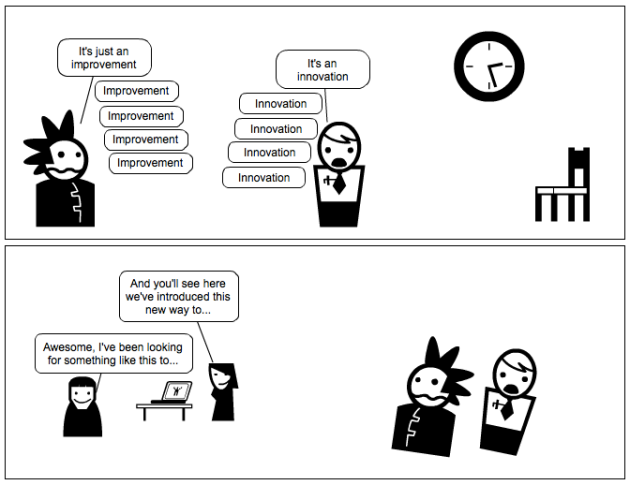Is it innovation or just an improvement? Does it matter?
April 3, 2014 Leave a comment
On the LinkedIn Front End of Innovation group, I saw this post:
Interesting (and heated) discussions @ Unleashing Innovation Summit in Amsterdam earlier in the month: Incremental innovation is NOT innovation – it’s just marketing. REAL innovation is breakthrough/transformational… Agree or not?
I’ve seen this debate before. Attempts to finally, once-and-for-all establish just where improvement ends and innovation begins. People end up with a Maginot Line that fails to defend the sanctity of innovation. Quick: Amazon 1-click purchasing…improvement or innovation?
Does it matter that we define innovation? I once collected a bunch of people’s definitions of innovation to celebrate the multiple ways people think about it. That was a nod to the different ways people think about it. It was divergence, not convergence.
But there are times people want a clearer line between innovation and improvement. Let’s see how some smart folks have articulated the difference.
Perspectives on defining innovation
Scott Berkun: Innovation is significant positive change. This is a high bar, and it should be. What does significant mean? I’d start with the invention of the light bulb, constitutional governments, wireless radio and maybe web browsers. Perhaps you could say significant is a 30% or more improvement in something, like the speed of an engine or the power of a battery. If you know the history of your profession you know the big positive changes people made over the last 50 years, giving you perspective on the scale of brilliance you need to have to be worthy of that word. (#)
Alan Lepofsky: Both innovation and improvement are important concepts, but unfortunately the two terms are often used interchangeably. Innovation reimagines an existing process or market, or creates a brand new one. Improvement enhances an existing process or market, but does not create disruption. (#)
Chris Andrews: I think your point highlights something important: there’s a pretty fine line between business-as-usual product improvements and real innovation, and it’s important not to confuse the two. (#)
Jon Van Volkinburg: I don’t see innovation as something that merely creates value for a customer and/or for the provider. Expanding or adding a service, feature, or function is not innovation, and these things create value. These things are growth, novelty, and invention. They are great, necessary, and can lead to innovation if the environment and timing is right. If you want, I guess you can call it incremental innovation… but I wouldn’t, to me the term “incremental innovation” is an oxymoron. (#)
What if we actually settled this debate once and for all?
Assume for a moment that we, as a society, agree on what constitutes Innovation. Then what? What is the logical flow of events and decisions that follow such a conclusion?
The reality it that doesn’t matter what something is called ex post facto. It only matters what impact it has on the consumers of the improvation.
Before seeking improvation:
- Understand the problem you’re addressing (no easy task itself)
- Develop a sense of the magnitude of what’s required (shave a few $1,000? develop a $1 billion market?)
- Be prepared to follow through on the ideas generated at a level commensurate with their scale
Here, it is important to understand how you define what you’re seeking. And it doesn’t matter whether you call it an improvement or an innovation. Afterwards, after the idea has become real? Again, it doesn’t matter what anyone calls it. It’s about how well it addresses the job-to-be-done. Call it what you want.
You like to-may-to,
And I like to-mah-to…





Your melded notion of “improvation” has a lot of parallels to what occurs when a company initiates a customer journey mapping program for a product, service, concept, process, etc. Before launching into the actual mapping exercises, having the situation, or the current path, fully understood from the customer’s perspective is absolutely critical. This will provide detail on resources (time, money, people, facilities, technology) prospectively involved with change, and the organization can then gain investment consensus at the outset. It’s essential to have this kind of discipline; and, as you note, at the end of the day, the only outcome that matters is delivering on the value-based ideas – be they improvement or innovation – identified.
Thanks Michael. Your concept of customer journey mapping sounds similar to the jobs-to-be-done framework. Jobs are the things someone is trying to get done, independent of what product is used. Customer journey mapping would seem to integrate the “job flow” somewhere in the journey, it seems.
Hutch